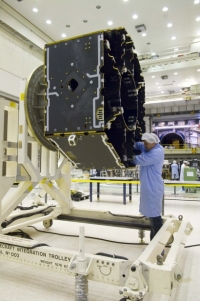LISA Pathfinder modules at ESTEC for system testing
20 August 2008
The science and propulsion modules of LISA Pathfinder have arrived at ESTEC for a series of system tests. These are devised to validate the spacecraft design parameters and to record the response of the LISA Pathfinder hardware to the launch environment by measuring acceleration loads on the spacecraft. The test campaign will continue until the end of 2008.
 |
|
LISA Pathfinder Science Module in a clean room at ESTEC (ESA) |
LISA Pathfinder, scheduled for launch in 2010, is the second of ESA's Small Missions for Advanced Research and Technology. It will pave the way for the ESA/NASA LISA mission by testing a number of critical LISA technologies in space and by performing the first in-flight tests of gravitational-wave detection metrology.
The spacecraft carries two payloads: the European LISA Technology Package (LTP) and the NASA-provided Disturbance Reduction System (DRS). Most elements of these payloads have been built and delivered to the respective prime contractors. Delivery of the final units is expected by the end of 2008. The current series of tests at ESTEC focuses on the characterisation of the spacecraft at system level.
Preparing for system tests
The science and propulsion modules which arrived at ESTEC in early August are currently being prepared for the first of the system tests: the acoustic tests that will be performed in the Large European Acoustic Facility (LEAF). During these tests both modules will be equipped with mass dummy units to represent the flight configuration.
Environmental tests are routinely performed on spacecraft during the implementation phase. In the case of LISA Pathfinder one of the payloads, the LISA Technology Package, contains some elements which are particularly sensitive to the stresses of launch: the optical bench which is made of Zerodur glass, and the complex caging mechanism that is used to hold the two gold proof masses in place during launch. This first set of acoustic tests will help to confirm the spacecraft design parameters and to characterise the acoustic loads on the payload. A complete series of environmental tests will be performed at a later date on the entire flight model including both the LTP and DRS payloads.
Separation shock tests
Once the acoustic tests have been completed a series of separation shock tests will be performed. The purpose of these shock tests is to measure the mechanical disturbance that results upon separation of the science and propulsion module stack from the launcher adapter, and also upon separation of the science module from the propulsion module. The parameters measured during these tests will be compared with previous analyses that have been made, in order to insure that they are within the range of values at which the individual units have been mechanically tested.
Upon completion of this system test series both the science and propulsion modules will be shipped back to the prime contractor, Astrium Ltd, UK.
Details of the tests will be provided in the LISA Pathfinder journals. These will be updated regularly during this test campaign.

